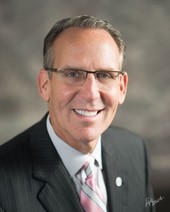Sections / Articles
Postscript: The Great Conversation
The importance of telling success stories about public schools.
By L. Earl Franks, Ed.D., CAE
Principal, September/October 2017. Volume 97, Number 1.
 Horace Mann, educator, politician, and the first great American advocate of public education, stated, “Education ... beyond all other devices of human origin, is a great equalizer of the conditions of men—the balance-wheel of the social machinery.” My experience affirms Mann’s declaration: I believe in public education; I am a product of public education; I would never have had the opportunities afforded me had it not been for public education. I am not alone in these convictions; countless of my fellow educators have shared similar anecdotes about the impact of public education on their lives.
Horace Mann, educator, politician, and the first great American advocate of public education, stated, “Education ... beyond all other devices of human origin, is a great equalizer of the conditions of men—the balance-wheel of the social machinery.” My experience affirms Mann’s declaration: I believe in public education; I am a product of public education; I would never have had the opportunities afforded me had it not been for public education. I am not alone in these convictions; countless of my fellow educators have shared similar anecdotes about the impact of public education on their lives.
How do we transform the dialogue about public education from the anecdotal to the tactical, creating capacity for support? It must begin with those of us who are involved in, believe in, and are passionate about the institution telling good news stories. If we are not willing to stand up and speak out in support of the power of public education, how can we expect those not involved to follow suit?
In his book, Schools Cannot Do It Alone: Building Public Support for America’s Public Schools (2010), author and education consultant Jamie Vollmer describes what he calls the “Great Conversation,” which he believes, and I whole-heartedly agree, needs to take place in our school buildings and school districts. “The people working in America’s public schools are often the largest and, potentially, most powerful force in the community,” he writes. To recalibrate the conversation about public education, he recommends following these simple-to-understand and easy-to-execute steps.
- Shift your attention from the negative to the positive.
- Stop bad-mouthing one another in public.
- Use your social networks to share something positive.
- Monitor progress.
According to Vollmer, we have everything we need to participate in this dialogue; we must only take the first step. “Each of us is already immersed in our own vibrant social networks that can act as conduits for our message. By adding this simple but essential ingredient, and without breaking the budget, every district is perfectly positioned to set the stage to unfold the full potential of every child,” he writes.
School building and school system administrators, as supporters of public education, must become passionately engaged in this “Great Conversation.” As you have seen from the political climate at both the state and federal levels, times are changing. We simply cannot afford to sit idly by and allow public education objectors to dismantle what Horace Mann referred to as “the greatest discovery made by man.”
To ensure the continuation of a thriving public education system, we must amplify our message about our passion for students and the successful instructional strategies that are making a difference in their lives. In short, we must join the conversation and tell our own success stories about the impact of public education. Our students deserve it.
L. Earl Franks is Executive Director of NAESP.
Watch my back-to-school video message to educators:
Copyright © National Association of Elementary School Principals. No part of the articles in NAESP magazines, newsletters, or website may be reproduced in any medium without the permission of the National Association of Elementary School Principals. For more information, view NAESP's reprint policy
| Attachment | Size |
|---|---|
| Postscript_SO17.pdf | 199 KB |